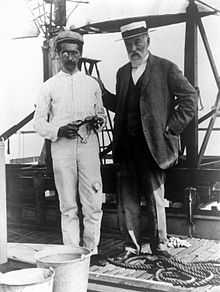Charles M. Manly


Charles Matthews Manly (1876-1927) was an American engineer who helped Smithsonian Institution Secretary Samuel Pierpont Langley build The Great Aerodrome, which was intended to be a manned, powered, winged flying machine.
Manly made major contributions to the development of the aircraft's revolutionary 52 hp gasoline-fueled radial engine, called the Manly-Balzer engine.
Manly attempted to pilot the Aerodome in its only two tests, October and December 1903. The machine failed to fly both times, plunging into the Potomac River after its launch from a houseboat. Manly was rescued unhurt, although he was briefly trapped underwater after the second test.
He was a 1929 posthumous recipient of the Langley Gold Medal from the Smithsonian Institution.
References
- "Charles M. Manly Papers, 1895-1925 (bulk 1903-1915)". National Air and Space Museum Archives. Smithsonian Institution. 2012. Retrieved 20 March 2013.
- Veal, C. B. (April 1939). "Manley, The Engineer". SAE (Society of Automotive Engineers) Journal: 145–153.